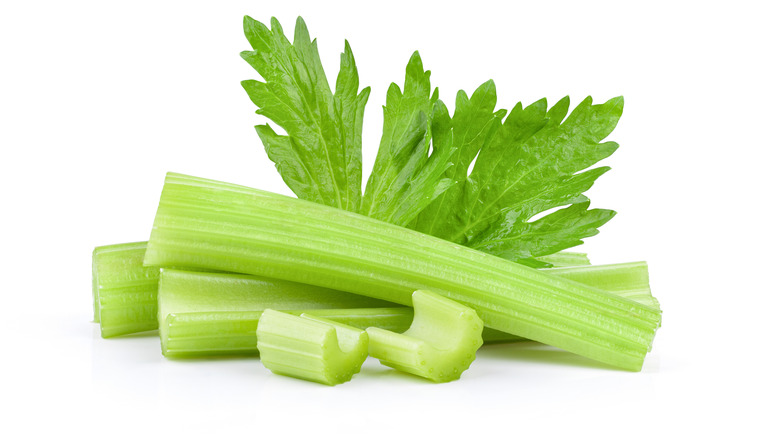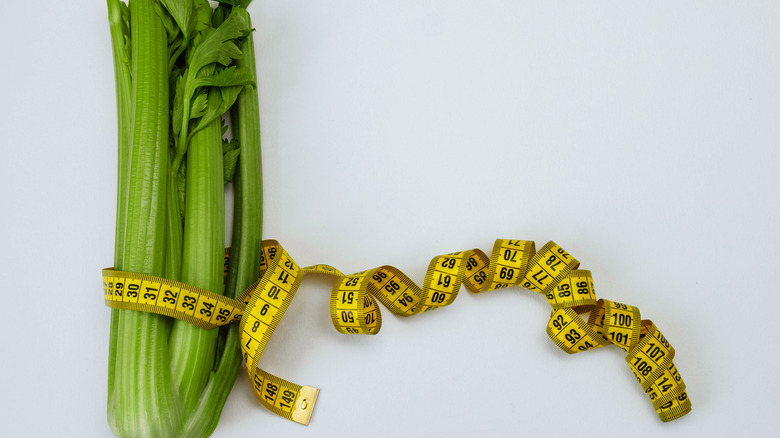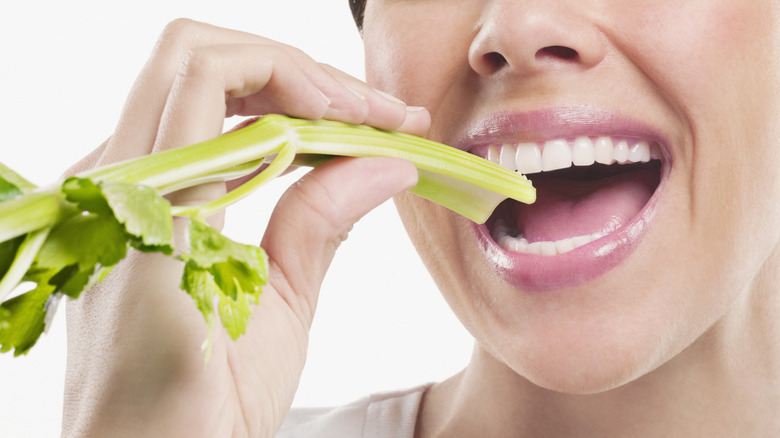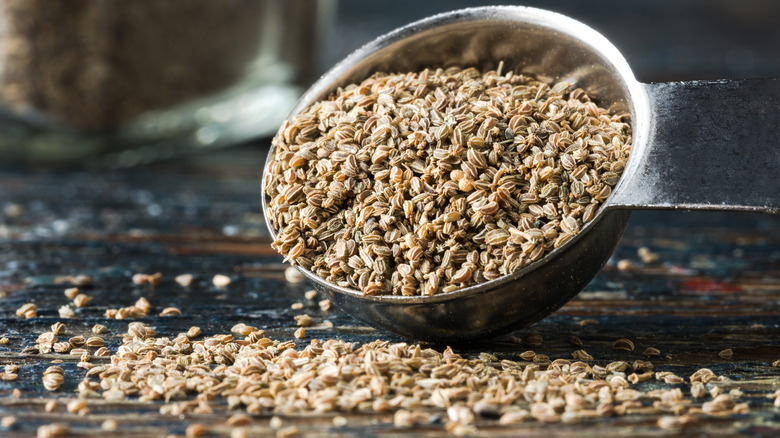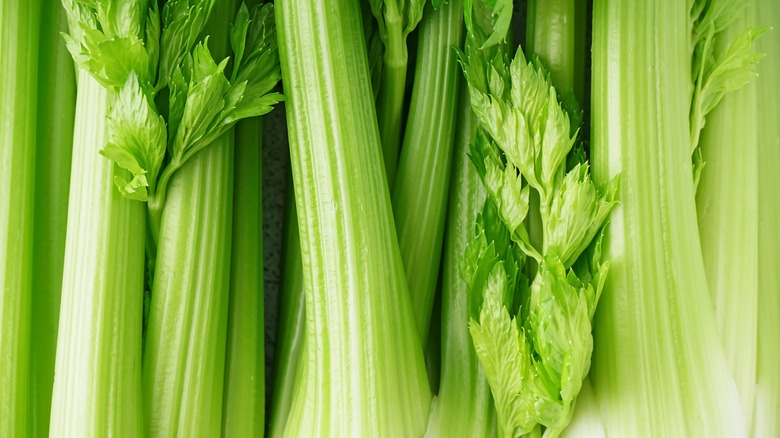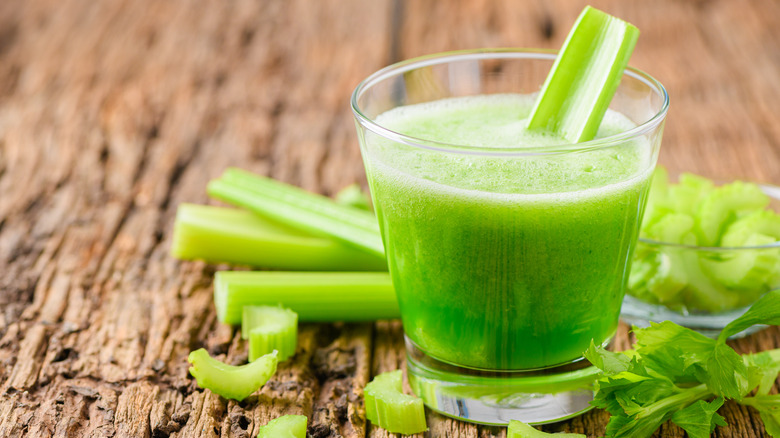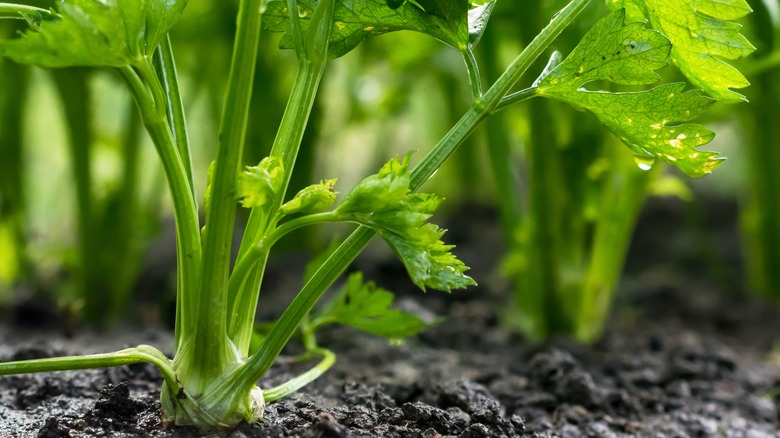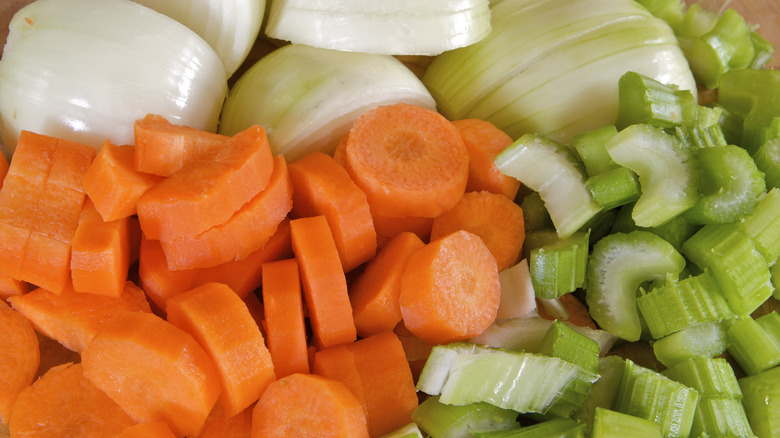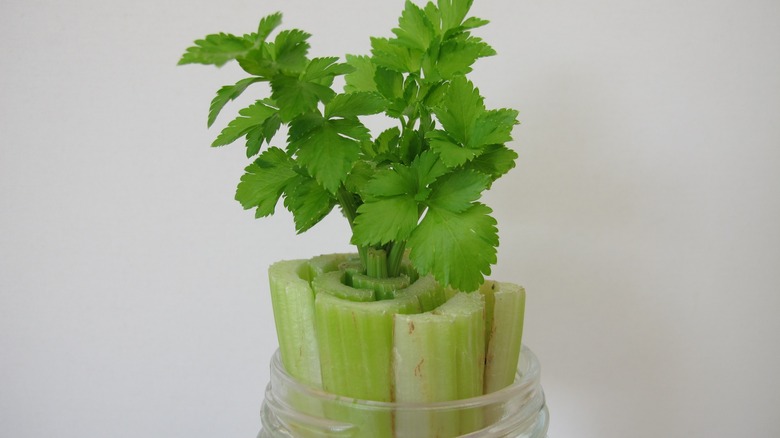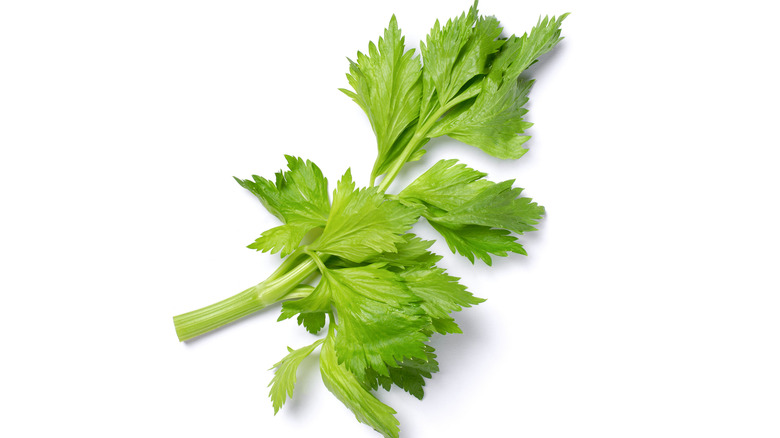False Facts About Celery You Thought Were True
Celery is, well, celery. It's crunchy but doesn't do much more than serve as a vehicle for dips or peanut butter, add crunch to stir-fries and tuna salad, and provide the main ingredient in classroom experiments about fluid absorption, right? At least that's how a lot of people see it. But celery has a more interesting history than it lets on, and gardeners can tell you a thing or two about what it's like to grow the vegetable — and their stories wouldn't be pretty.
The seemingly simple stalks play a vital role in cooking and provide more benefits than their appearance would let on. When you think about it, celery shows up in so many different recipes (even in drinks like a Bloody Mary) that you know there's got to be more to its story than what you've likely heard. You're right, and it's time to clear away the mythological mist and look at false facts about celery you thought were true.
False: It's a negative-calorie food
Let's address this first because it's one of those claims that has become almost synonymous with celery in the weight-loss world: No, celery isn't a negative-calorie food that makes you burn more calories chewing it than it gives you after digestion. A negative-calorie food is supposed to make you lose weight as you eat, so the concept is understandably popular. Several foods have this reputation, but celery is the king of them all because its fibrous texture requires more chewing and thus more exertion and its low-calorie count sounds negligible on paper. This negative-calorie claim has been around for years, and it's generally considered false.
Some unofficial and small studies show a tiny, tiny excess calorie burn when eating celery. However, the results of tests like those depend on a person's metabolic rate, as well as how long they chew. Someone who chews celery for longer than is necessary is likely going to burn a smidge more than someone who chews the celery just long enough to be able to swallow it. But that excess burned amount could quickly be eliminated by whatever else the person ate that day. Celery is a terrific food if you're trying to cut calories, but it's not magic.
False: It's devoid of nutrients
Celery may often be very light in color, but that doesn't mean it's a nutritional wasteland. It's got a decent amount of vitamins, minerals, and fiber, including vitamin K (specifically K1, or phylloquinone). This vitamin supports blood clotting and bone health, and while K1 is available in many foods, celery is a particularly abundant source. It's also a great source of antioxidants that help reduce and treat inflammation and related disorders. Remember, foods don't have to contain every single nutrient to be nutritionally valuable. Celery may also help shore up your joints, cardiovascular health, and even blood pressure.
Celery can be processed to provide celery juice, which we'll look at more in-depth later on. Forgetting about the huge health claims surrounding it for a moment, what celery juice is abundant in is water. Hydration is so important for health, and people don't always get the liquid intake they need. Dehydration can result in hospitalization, especially among older adults. For those who don't mind the taste, celery juice is one way to increase your hydration level.
False: You can eat as much as you want because it's healthy
Too much of a good thing isn't necessarily a good thing here. This goes for any food or drink; even clean, drinkable water can be dangerous in excessive amounts. Celery's danger lies not in getting an overabundance of the food but in an underabundance of nutrients. Celery isn't devoid of nutrients, with not only vitamin K but also vitamins A and C, potassium, and smaller amounts of other nutrients like iron. But its amounts aren't enough to provide all your needed nutrition. Eating so much celery that you're not eating much else sets you up for malnutrition. Plus, those low-calorie amounts that are so good for weight loss? A day full of celery is a day lacking adequate amounts of calories to keep your brain and body functioning well. You could experience lowered energy and increased cognition issues if you ate too few calories for too long.
Another issue has to do with a compound called mannitol. This is a natural substance found in celery, but if you have too much of it, you could develop a problem with gas or a bloated feeling. Oddly, too much celery with mannitol can contribute to dehydration, despite celery's water content. Mannitol in injection form is used as a diuretic, so don't go overboard drinking celery juice for hydration. As with any other "healthy" food, stick to moderate amounts of celery.
Surprisingly false: It's always been kind of basic
Celery is so common now that it's not surprising it's considered one of the most basic vegetables available. However, its history is a lot wilder than its stalks let on. Celery was once highly sought after and treated as a delicacy. That sounds hard to believe as you unceremoniously pry a celery rib fiber from between your teeth, but it's true.
The celery eaten today was carefully bred over generations from a bitter, wild form that was used medicinally. The wild form still exists, but if you compare the two, they won't look or taste that similar. The wild form was used for its seeds, but botanists saw the plant's potential and got to work on breeding a variety with edible stalks. In the 17th century, a French botanist started working on a variety that became a viable part of gardens less than a century later, although those didn't have modern celery's distinct shape and weren't usually eaten raw. Continued efforts by plant breeders eventually produced the varieties you see today.
The late 19th century was a turning point. Because celery was still hard to obtain, it became somewhat of a Victorian delicacy, even being served in a special dish called a celery vase (and later, a celery tray). Widespread cultivation in the U.S. started in the late 1800s in Michigan, which had a perfect climate for it. Celery was served as a holiday vegetable well into the 20th century.
False, at least commercially: Celery seed spice comes from the same plant
Celery seeds are the seeds of the celery plant, but there are two different types of celery seeds. One is the commercial celery seed that you buy in the spice aisle at the grocery store, and the other is the celery seed that you get home-grown celery to produce. While you could technically use that home-produced seed as the spice, it's not the same as the stuff you get at the store.
Commercially grown celery seed comes from wild celery, also called smallage. Cultivated celery descends from wild celery, so the two types of seeds are related. However, wild celery has longer, thinner stalks that aren't edible, and its leaves are too bitter to use. You may see some sources say that celery seed comes from Chinese celery and that Chinese celery is also called smallage. Chinese celery is related to both wild and North American/European cultivated celery, but Chinese celery is itself a cultivated form that has edible stalks and much tastier leaves than wild celery.
Unproven, so false for now: It's an aphrodisiac
Celery has a supposed use as an aphrodisiac, but so far, there's no official research proving that it works. And there's not even that much in the way of anecdotal "evidence," either — just a lot of historical claims. Celery was used in Roman times and ostensibly by others (famed ladies' man Casanova being one) as an aphrodisiac, but whether they felt effects from the celery or the placebo effect is unknown. So, for now, this claim remains false.
Those making the claim nowadays are trying to base it on science, but that still doesn't make up for the lack of proof. Celery may contain androsterone, according to some studies, which is a pheromone. However, there isn't a whole lot of it present. Androsterone can influence male characteristics, but again, that's not enough to call it an actual aphrodisiac.
False: Celery juice solves everything
Even the humble celery stalk has fallen under the health-influencer microscope — or camera lens, as it may be. Celery juice has long been used as a health tonic and serves as the base for one of the more interesting soda flavors around. But it's not the cure-all that social media and many health bloggers would have you believe.
One cup of celery juice does contain a good amount of different vitamins, especially vitamin K. It's just like eating solid celery in that respect, although by removing the bulk of the vegetable, you're not getting as much fiber. And of course, you're getting all that water. But that doesn't mean drinking celery juice is going to solve your health problems.
While celery has had medicinal uses in the past, nowadays people claim that the juice (whether actually juiced or blended instead) can cure everything from acne and psoriasis to shingles, strep, and chronic fatigue. Unfortunately, no one has studies to back that up, especially not studies done with humans. Celery juice will provide water and some vitamins and minerals but don't expect it to clear up all difficult health problems.
Gardeners will tell you this is false: Celery is so easy to grow
Celery is one of the harder vegetables to grow due to how picky, how easily damaged, and how attractive it can be to pests. Yes, growing it is straightforward, but it requires a lot of care. One of the problems is that celery usually has to be trenched, meaning that you have to periodically place more soil around the stalks, eventually covering a good portion. This creates a condition called blanching that leads to lighter-colored and more tender stems. Some varieties of celery can self-blanch, meaning you don't have to worry about trenching.
But that's not the only issue. Celery likes cool-to-moderately warm temperatures and moist soil, but it also needs full sun. You may have to start amending and preparing the soil months in advance. It can take weeks for germination to begin, and believe it or not, you'll need to protect your skin when growing celery because it can cause skin rashes or photosensitivity due to compounds called furanocoumarins. In fact, in 1986, grocery store workers and others who handled lots of celery started developing strange rashes on their arms, and the problem was traced to a disease-resistant variety of celery that groceries had started selling that had very high levels of furanocoumarins. Aphids, slugs, snails, and fungal diseases love celery, so be on the lookout for those if you're growing your own.
False: Celery powder is a safer ingredient in preserved meats
Celery powder acts to help preserve meat and often replaces added artificial nitrates and nitrites in uncured bacon and deli meat. Added nitrates and nitrites counter bacteria and add color to meat but have been shown to have deleterious long-term health effects, including increasing the risk of certain cancers. Scientists found that celery juice contained nitrates that could be converted to nitrites when combined with certain bacteria. It also didn't change the flavor of the meat that much, so food processors started using a powdered version as a substitute for artificial nitrites. Celery powder was considered a flavoring, so the foods it was in could be labeled as uncured and free of nitrites despite the amount naturally in that celery powder.
Unfortunately, research is now showing that when used in a meat-preservation environment, celery powder isn't that different from added nitrates and nitrites. The nitrites it produces combine with meat to form nitrosamines, which are the compounds that have been linked to cancer. That's not to say celery powder or celery itself is evil; eating celery or using celery powder that you buy in the spice aisle at the store isn't going to have the same effect. In fact, studies have shown that eating vegetables like celery is associated with a lower risk of cancer.
False: Celery doesn't have much taste
Raw celery is crunchy and cool, but it's also a background flavor most of the time. That's on purpose, though. Wild celery was too bitter to eat, so botanists put it through selective breeding to make it more palatable. But it does mean that whatever the celery's been dipped in usually takes the front row. Saying celery doesn't have much taste at all is false, however, because celery's flavor isn't so much in the raw stuff, but in what happens when you cook it.
Celery contributes a lovely flavor and texture to dishes, especially as a part of mirepoix and the Cajun "Holy Trinity." Mirepoix is a mix of onions, carrots, and celery, and the Holy Trinity is a mix of onions, celery, and green bell pepper. Both of these are used in soups, stews, and countless other recipes to enhance how rich the dishes taste. While all of the aromatics in these combinations contribute to the effect, celery is a standout in terms of flavoring power. It contains volatile compounds that deepen the taste of broth and other foods, and it combines well with the other aromatics in the combinations. Celery also blends well with the more acidic taste of tomato juice, hence its continued use as a Bloody Mary ingredient. Fun fact: According to the Royal Horticultural Society, this combination may have been discovered by accident when a guest couldn't find a swizzle stick for his drink and ended up grabbing a celery stick.
A combination of true and false: You can regrow store-bought celery in a cup of water
Celery is one of those vegetables that can start to regrow in just water. You may remember a few years ago when bloggers marveled over how you could place the root bulb of green onion in water and get the onion to grow again; celery is similar. The internet is full of very happy home gardeners who've posted pictures of tiny leaves emerging from the celery-bunch bottoms that they'd plunked down in the water. It's cool to see, and it's a great activity to do just for fun.
Unlike green onions, which can regrow a few times in water before fading, celery won't turn into a full bunch with long stalks again. You'll see the stalks and roots begin to grow within a few days of placing the celery piece in water, but the re-growing celery needs to go back into a soil environment for two reasons. One is that the outer stalks on the piece you put in the water can rot quickly.
The other is that the water won't provide nutrients. The piece of celery does have a little nutrition in reserve. But it's not a lot, and once the piece begins to rot, the stalks aren't going to have much time left anyway. Planting the piece in nutrient-laden soil once the roots and new stalks are a couple of inches in length helps the plant take up and store nutrients.
False: Throw the leaves away
Photographs of celery actually in use in recipes tend to focus on whole, sliced, or diced stalks, with no leaves in sight. Ready-to-eat snack packs contain only trimmed stalks, and chances are good that if you were ever given celery and peanut butter as a kid, you got a celery stick with no leaves. That can give the impression that the leaves aren't useful or even edible, which is completely false. Celery leaves are not only edible — they're also delicious and super versatile.
First, yes, you can add them to salads! This is great news if you buy stalks that have beautiful leaves that you'd prefer not to boil or blend. They make a beautiful edible garnish, too. Try drying the leaves and grinding them up with salt to make your own celery salt. Combine the leaves with eggs in omelets, or add them to potato salads and any other dishes that use celery stalks. The only reason why you wouldn't add the leaves to anything that uses celery is that you're saving the leaves for something else, so think twice before you throw them away.
